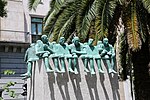Theatre of María Guerrero
Bien de Interés Cultural landmarks in MadridBuildings and structures in Justicia neighborhood, MadridEntertainment venues in MadridEuropean theatre (structure) stubsSpanish building and structure stubs ... and 1 more
Theatres in Madrid

The Theatre of María Guerrero (Spanish: Teatro María Guerrero) is a theatre located in Madrid, Spain. It was declared Bien de Interés Cultural on 1 March 1996. It is the home of the national theatre of Spain, Centro Dramático Nacional.Its plays was programmed on 15 January 1934 until 1935, when it was remodeled. It was closed on 27 April 1940 because Spanish Civil War started. It was directed successively by Luis Escobar Kirkpatrick (with Huberto Pérez de la Ossa as subdirector) (1940-1952), Claudio de la Torre (1952-1960) and José Luis Alonso Mañés (1960-1975).
Excerpt from the Wikipedia article Theatre of María Guerrero (License: CC BY-SA 3.0, Authors, Images).Theatre of María Guerrero
Calle de Tamayo y Baus, Madrid
Geographical coordinates (GPS) Address Phone number Website External links Nearby Places Show on map
Geographical coordinates (GPS)
| Latitude | Longitude |
|---|---|
| N 40.422915 ° | E -3.693006 ° |
Address
Teatro María Guerrero
Calle de Tamayo y Baus 4
28004 Madrid (Centro)
Community of Madrid, Spain
Open on Google Maps









